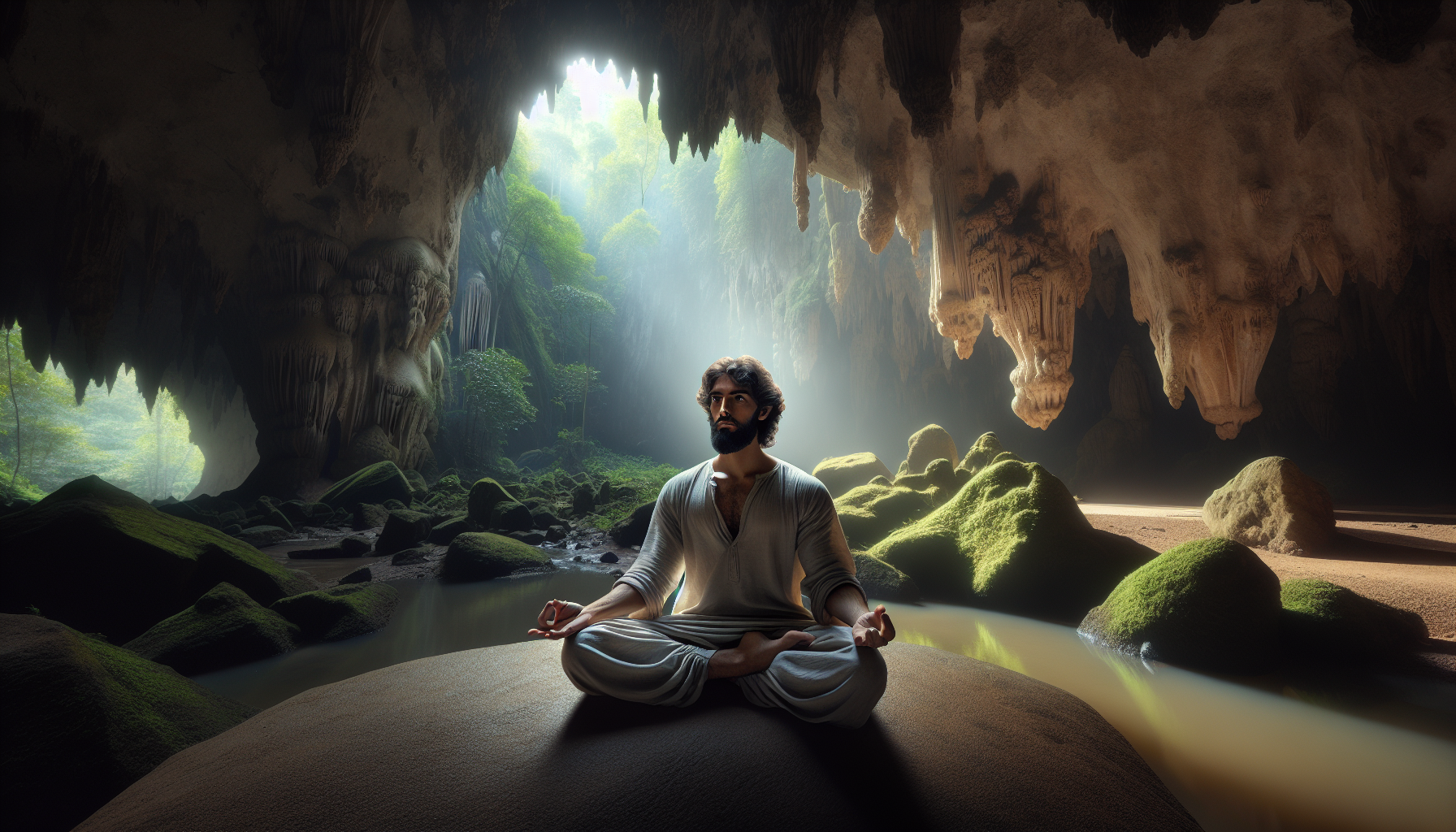In a world that never seems to slow down, where the cacophony of daily life often drowns out our inner voice, finding a moment of tranquility can feel like an elusive dream. Yet, amidst the chaos, a timeless practice offers a sanctuary of serenity—meditation. Now, imagine elevating this experience by stepping into the embrace of nature, specifically within the ancient and mystical confines of a natural cave. The combination of meditation and the primal beauty of these natural formations holds the promise of profound inner peace and self-discovery. 🌿
The allure of meditating in a natural cave goes beyond the mere novelty of the location. Caves have been revered throughout history as sacred spaces, places of refuge, and portals to spiritual enlightenment. The geological wonders that form these underground sanctuaries—stalactites and stalagmites sculpted over millennia—create an atmosphere of awe and reverence. In these hallowed halls, silence takes on a tangible quality, enveloping you in a cocoon of stillness that is rare in our hyper-connected world. This unique environment not only enhances the meditative experience but also fosters a deeper connection to the earth and oneself.
In the upcoming sections, we will explore the multifaceted benefits of meditating in natural caves, diving into how these ancient spaces can amplify the effects of meditation. We will discuss the science behind the calming acoustics and naturally cool temperatures of caves, which contribute to a more focused and restorative meditative state. Furthermore, we’ll delve into the psychological impact of being surrounded by nature’s grandeur, and how this can lead to heightened creativity, emotional healing, and a profound sense of inner peace.
Whether you’re a seasoned meditation practitioner or a curious beginner, this exploration of meditation in natural caves promises to be an enlightening journey. We will guide you through practical tips on how to prepare for such an experience, what to expect, and how to integrate the insights gained from this practice into your daily life. By the end of this article, you will not only appreciate the transformative power of meditation but also feel inspired to seek out your own sacred cave—a place where you can rediscover your inner peace and unleash the tranquility that resides within. 🧘♀️
The History and Significance of Meditation in Caves
Meditation has been an integral part of human spirituality and self-discovery for centuries. The practice of meditating in natural caves, in particular, offers a unique blend of solitude, tranquility, and a connection to the earth that is hard to replicate elsewhere. Caves, with their ancient history and untouched beauty, provide an ideal setting for those seeking to deepen their meditation practice and find inner peace.
Historically, caves have been used as sanctuaries for meditation by various cultures and spiritual leaders. In ancient India, for example, the revered yogis and sages would retreat to the Himalayas’ caves, seeking enlightenment and spiritual growth away from the distractions of everyday life. These caves were considered sacred spaces where one could connect with higher powers and gain profound insights. Similarly, in China, Taoist monks often meditated in mountainous caves, drawing inspiration from the surrounding nature to achieve harmony and balance.
The physical environment of a cave itself contributes to the meditative experience. The cool, dark, and silent atmosphere helps to remove sensory distractions, allowing individuals to focus their attention inward. The steady, rhythmic sound of dripping water or the gentle rustling of bats can serve as natural aids to deepen meditation. This unique environment fosters a sense of timelessness and stillness, encouraging practitioners to explore the depths of their consciousness.
In modern times, the appeal of meditating in natural caves has seen a resurgence. As more people seek to unplug from the digital world and reconnect with nature, caves offer a perfect escape. The experience is not just about the absence of noise but also about embracing the simplicity and raw beauty of the natural world. This profound connection with nature is often a catalyst for inner transformation and peace.
Benefits of Meditating in Natural Caves
Meditating in natural caves offers several benefits that enhance the traditional practice of meditation. One of the primary advantages is the profound sense of isolation and detachment from the hustle and bustle of modern life. Caves provide a serene environment where the only focus is on the present moment and the inner journey. This solitude allows for deep introspection and the opportunity to address personal challenges and emotions without external interference.
Moreover, the natural acoustics within a cave can amplify the effectiveness of meditation. The enclosed space allows for the resonance of sound, which can be particularly beneficial when practicing techniques such as chanting or using singing bowls. The echoes create a unique auditory experience that can help elevate the meditative state, leading to greater mental clarity and relaxation.
The physical benefits of cave meditation are also noteworthy. The consistent temperature within a cave helps regulate the body’s core temperature, creating an optimal environment for prolonged meditation sessions. The lack of direct sunlight minimizes distractions and promotes a state of calmness and focus. Additionally, the fresh air and natural minerals present in caves can have therapeutic effects, enhancing overall well-being.
For those interested in exploring meditation in caves, it’s essential to choose locations that are safe and accessible. Many natural caves offer guided meditation retreats, providing a structured approach to help individuals maximize their experience. These retreats often incorporate other wellness activities such as yoga, breathwork, and nature walks, offering a holistic approach to mental and physical health.
Comparative Table: Meditation in Caves vs. Traditional Meditation Spaces
Explore the key differences between meditating in natural caves and traditional meditation spaces like studios or home environments in the table below.
| Aspect | Meditation in Caves | Traditional Meditation Spaces |
|---|---|---|
| Environment | Natural, secluded, and tranquil; offers a unique sensory experience | Controlled, often urban; may include ambient noise or distractions |
| Acoustics | Natural echoes enhance auditory meditation techniques | Dependent on room design and soundproofing |
| Temperature | Consistent, cool; reduces physical distractions | Variable; may require artificial climate control |
| Connection to Nature | Direct and profound; promotes a deeper sense of peace | Limited, often supplemented by indoor plants or nature soundtracks |
Preparing for a Meditation Retreat in Natural Caves
Embarking on a meditation retreat in a natural cave is a transformative experience that requires thoughtful preparation. Ensuring a safe and fulfilling journey involves both mental and physical readiness. Below are key considerations and steps to prepare for a successful cave meditation retreat.
Firstly, research and select a retreat that aligns with your meditation goals and experience level. Many organizations offer cave meditation retreats worldwide, each with varying levels of intensity and focus. Consider whether you prefer a guided experience with structured schedules and activities or a more self-directed retreat that allows for personal exploration. Reading reviews and testimonials can provide valuable insights into what to expect.
Physical preparation is equally important. Caves can have uneven terrain, and the journey to reach them might involve hiking or climbing. Engaging in regular physical exercise and flexibility training can enhance your endurance and mobility, making the trek to the cave more manageable. Ensure you have appropriate gear, such as sturdy footwear, breathable clothing, and a reliable backpack for carrying essentials like water, snacks, and a flashlight.
Mental preparation involves setting clear intentions and goals for your meditation retreat. Reflect on what you hope to achieve or discover during your time in the cave. This could include personal growth, stress relief, spiritual enlightenment, or simply a break from the routine. Journaling about your intentions and challenges before the retreat can help clarify your objectives and provide a reference point during your journey.
Additionally, familiarizing yourself with basic meditation techniques and breathing exercises can enhance your experience. Practicing mindfulness, deep breathing, and visualization before the retreat will make it easier to adapt to the cave’s unique environment. Joining local meditation groups or online forums can also provide support and tips from fellow enthusiasts.
Essential Items for a Cave Meditation Retreat
To ensure a comfortable and enriching experience, consider packing the following items for your meditation retreat:
- Comfortable and durable clothing suitable for the cave environment
- Non-slip footwear with good grip for rocky or uneven surfaces
- A meditation cushion or mat for seating comfort
- Flashlight or headlamp for navigating dark areas
- Water bottle and snacks to maintain hydration and energy levels
- A journal and pen for recording reflections and insights
- Personal items such as a small first-aid kit and insect repellent
Stories and Experiences from Cave Meditation Practitioners
Hearing about others’ journeys can inspire and guide those interested in cave meditation. Many practitioners report profound personal transformations and insights gained from their time spent in caves. For instance, the story of a corporate executive who turned to cave meditation to combat burnout showcases the healing potential of such retreats. The executive described the experience as life-changing, citing a newfound sense of clarity, purpose, and inner peace.
Another practitioner, a seasoned meditator, shared how meditating in caves deepened her practice. Despite years of meditation experience, she found the cave environment uniquely conducive to achieving a state of deep focus and connection with her inner self. The absence of artificial distractions and the presence of natural sounds amplified her meditative state, allowing her to reach new levels of consciousness.
For those who have never meditated in a natural cave, the prospect can be both exciting and daunting. However, the shared experiences of seasoned practitioners highlight the universal themes of self-discovery, peace, and rejuvenation that come from such retreats. Embracing the unknown and surrendering to the experience can lead to unexpected insights and personal growth.
To learn more about personal experiences and benefits of meditation in caves, watch the insightful video below:
“Finding Peace in Nature’s Embrace: The Cave Meditation Experience” – Peaceful Mind Channel

Conclusion
Finding inner peace is a quest that has captivated human minds for centuries. In our modern, fast-paced world, this pursuit has become more significant than ever. The article explored the unique and transformative experience of practicing meditation in natural caves, a practice that is both ancient and profoundly relevant today.
We began by delving into the history of meditation, a practice rooted in diverse cultural and spiritual traditions. From the ancient yogis of India to the Buddhist monks of Tibet, meditation has been a cornerstone for achieving mental clarity and emotional balance. The historical context provided a foundation for understanding why meditation remains a powerful tool for personal growth and spiritual development.
The article then highlighted the distinctive benefits of meditating in natural caves. These geological formations offer a serene and undisturbed environment that enhances the meditative experience. The cool, dark, and quiet setting of a cave provides a perfect backdrop for introspection and mindfulness, allowing practitioners to disconnect from the chaos of everyday life and reconnect with their inner selves. The unique acoustics and natural energy of caves can amplify meditation’s effects, making it easier to reach deeper states of consciousness.
Moreover, we discussed the scientific underpinnings of meditation, supported by research that demonstrates its impact on mental and physical well-being. Studies have shown that meditation can reduce stress, lower blood pressure, and improve emotional resilience. Practicing meditation in a natural cave can enhance these benefits by providing a setting that naturally calms the mind and body.
Additionally, we explored the practical aspects of finding and accessing caves suitable for meditation. While not everyone has access to natural caves, the article suggested creative alternatives, such as finding secluded outdoor spaces or even using virtual reality experiences that mimic the ambiance of a cave. These suggestions ensure that the transformative experience of cave meditation is accessible to a broader audience.
In conclusion, the journey to finding inner peace through meditation in natural caves is a profound and enriching one. It connects us to the ancient traditions that have revered these natural sanctuaries as places of spiritual refuge and healing. By embracing this practice, individuals can unlock a wellspring of tranquility and clarity that enhances all aspects of life.
As you reflect on the insights shared in this article, consider how you might integrate meditation into your own routine. Whether you have the opportunity to meditate in a natural cave or find solace in other tranquil settings, the key is to prioritize moments of stillness and introspection. By doing so, you not only enhance your well-being but also contribute to a more peaceful and harmonious world. 🌿
We invite you to share your thoughts and experiences. Have you tried meditating in a natural cave or similar setting? How has meditation impacted your life? Your insights and stories could inspire others on their journey to inner peace. Feel free to comment, share this article with friends, or explore further resources on meditation and its benefits. Together, we can cultivate a community committed to personal and collective well-being. 🌟
Toni Santos is a visual storyteller and cognitive explorer whose work delves into the mental landscapes of ancient cultures—revealing how different civilizations perceived reality, memory, and meaning long before modern psychology existed. Through symbolic imagery and narrative inquiry, Toni brings to life the divergent ways of thinking that shaped lost worlds.
His creative path is guided by a fascination with non-linear logic, oral cosmologies, and the mythic frameworks that once guided decision-making, emotion, and identity. From memory temples carved in stone to visual languages encoded in textiles, every piece Toni creates reflects the vast cognitive diversity of the human story.
With a foundation in visual design and cultural semiotics, Toni blends analytical depth with artistic expression. His work goes beyond historical reconstruction—it reawakens the embodied, intuitive, and ritual-based intelligence of ancient minds, inviting us to question the assumptions of modern thought.
As the mind behind Vizovex, Toni curates visual studies, essays, and immersive content that explore forgotten epistemologies—ways of knowing that connected people to myth, land, and each other in profoundly different ways.
His work is a tribute to:
The symbolic intelligence of pre-modern cultures
The neural diversity embedded in ancient rituals and storytelling
The deep memory systems that shaped identity and perception
Whether you’re a researcher, an artist, or a seeker of hidden wisdom, Toni invites you to enter a space where cognition is culture, and where the past speaks through signs, cycles, and symbols—one myth, one memory, one mind at a time.





